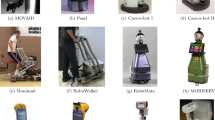Abstract
In the next decades, the growth in population aging will cause important problems to most industrialized countries. To tackle this issue, Ambient Assistive Living (AAL) systems can reinforce the well-being of elderly people, by providing emergency, autonomy enhancement, and comfort services. These services will postpone the need of a medicalized environment and will allow the elderly to stay longer at home. However, each elderly has specific needs and a deployment environment of such services is likely unique. Furthermore, the needs evolve over time, and so does the deployment environment of the system. In this paper, we propose the use of a model-based development method, the adaptive medium approach, to enable dynamic adaptation of AAL systems. We also propose improvements to make it more suited to the AAL domain, such as considering heterogeneity and a composition model. The paper includes an evaluation of the prototype implementing the approach, and a comparison with related work.








Similar content being viewed by others
Notes
Survey of Health, Ageing and Retirement in Europe, http://www.share-project.org.
A set-top box is a programmable hardware connected to a TV set.
We voluntarily don’t consider whether the triggering of the adaptation is manual or automatic, as it is out of scope of this work.
References
Anastasopoulos M, Klus H, Koch J, Niebuhr D, Werkman E (2006) DoAmI—a middleware platform facilitating (Re-)configuration in ubiquitous systems. In: System Support for Ubiquitous Computing Workshop. 8th Annual Conf. on Ubiquitous Computing (Ubicomp’06)
Bennour B, Henrio L, Rivera M (2009) A reconfiguration framework for distributed components. In: ESEC/FSE workshop on software integration and evolution at runtime, pp 49–56
Buisson J (2006) Adaptation dynamique de programmes et composants parallèles. PhD thesis, INSA de Rennes, IRISA
Cariou E, Beugnard A, Jézéquel J (2002) An architecture and a process for implementing distributed collaborations. In: Proceedings of the 6th International Enterprise Distributed Object Computing, pp 132–143
Cetina C, Giner P, Fons J, Pelechano V (2009) Building self-adaptive services for ambient assisted living. In: Int. Workshop of Ambient Assisted Living (IWAAL), Salamanca, Spain
Cheung-Foo-Wo D (2009) Adaptation dynamique par tissage d’aspects d’assemblage. PhD thesis, Univ. de Nice Sophia Antipolis
David P-C, Ledoux T, Léger M, Coupaye T (2009) FPath and FScript: language support for navigation and reliable reconfiguration of fractal architectures. In: annals of telecommunications: special issue on software components. The fractal initiative, vol 64, n1/2. Springer, Paris
Dufrène G, Seinturier L (2008) Un ADL pour les architectures distribuées composants Hétérogènes. In: 2nd Conf. Francophone sur les Architectures Logicielles, Montréal, Canada
Flissi A, Dubus J, Dolet N, Merle P (2008) Deploying on the grid with DeployWare. In: 8th Int. symp. on cluster computing and the grid (CCGRID’08), Lyon, France, pp 177–184, 18–22 May 2008
Fuentes L, Jiménez D, Pinto M (2006) Development of ambient intelligence applications using components and aspects. J Univers Comput Sci 12(3):236–251
Hamoui F, Huchard M, Urtado C, Vauttier S (2009) Specification of a component-based domotic system to support user-defined scenarios. In: Proc. of 21st int. conf. SEKE, Boston, MA, USA, pp 597–602
Hoareau D, Mahéo Y (2008) Middleware support for the deployment of ubiquitous software components. Personal and ubiquitous computing, vol 12. Springer, London, pp 167–178
Kaboré E, Beugnard A (2008) Implementing a data distribution variant with a metamodel, some models and a transformation. In: Proc. 8th IFIP DAIS, Oslo, Norway
Nain G, Daubert E, Barais O, Jézéquel J (2008) Using MDE to build a schizophrenic middleware for home/building automation. In: ServiceWave 08: NESSI Conference, Madrid. Springer, Spain, p 61
Nehmer J, Karshmer A, Becker M, Lamm R (2006) Living assistance systems—an ambient intelligence approach. Int Conf Softw Eng
Phung-Khac A (2010) A model-driven feature-based approach to runtime adaptation of distributed software architectures. Phd thesis, Télécom Bretagne
Pessemier N, Seinturier L, Duchien L, Coupaye T (2008) A component-based and aspect-oriented model for software evolution. Int J Comput Appl Technol 31:94–105
Rouvoy R, Eliassen F, Floch J, Hallsteinsen S, Stav E (2008) Composing components and services using a planning-based adaptation middleware. Lect Notes Comput Sci 4954:52–67
Schneider D, Becker M (2008) Runtime models for self-adaptation in the ambient assisted living domain. Fraunhofer Publica, Germany
Seinturier L, Merle P, Fournier D, Dolet N, Schiavoni V, Stefani J-B (2009) Reconfigurable SCA applications with the FraSCAti platform. In: International conference on services computing, pp 268–275, Sep 2009
Thépaut A, Segarra MT, Lohr C, Chapon PM (2010) Project for the autonomy of the elderly: an approach design for all. In: Int. Soc. for Gerontechnology, 7th World Conf., Vancouver, Canada
Acknowledgments
The authors would like to thank the Direction Générale des Entreprises for their funding, and the members of the SIGAAL project [21].
Author information
Authors and Affiliations
Corresponding author
Rights and permissions
About this article
Cite this article
Lézoray, JB., Segarra, MT., Phung-Khac, A. et al. A design process enabling adaptation in pervasive heterogeneous contexts. Pers Ubiquit Comput 15, 353–363 (2011). https://doi.org/10.1007/s00779-010-0356-y
Received:
Accepted:
Published:
Issue Date:
DOI: https://doi.org/10.1007/s00779-010-0356-y




